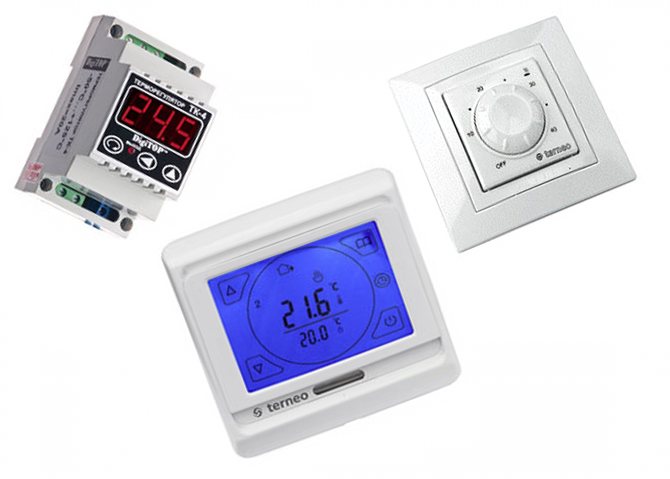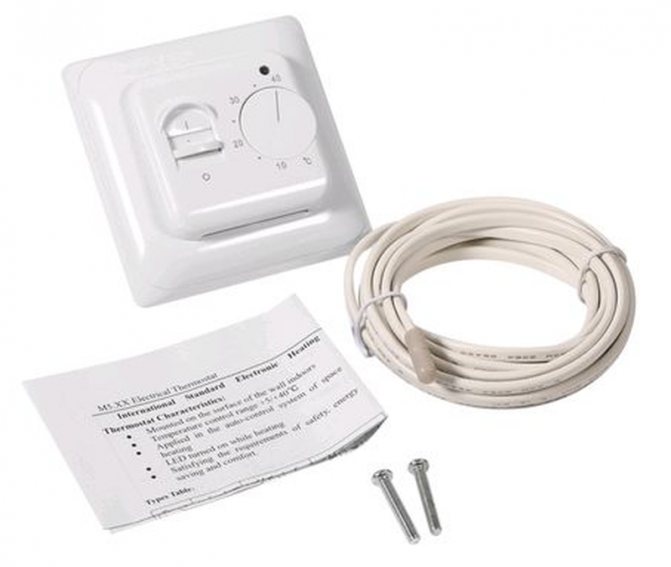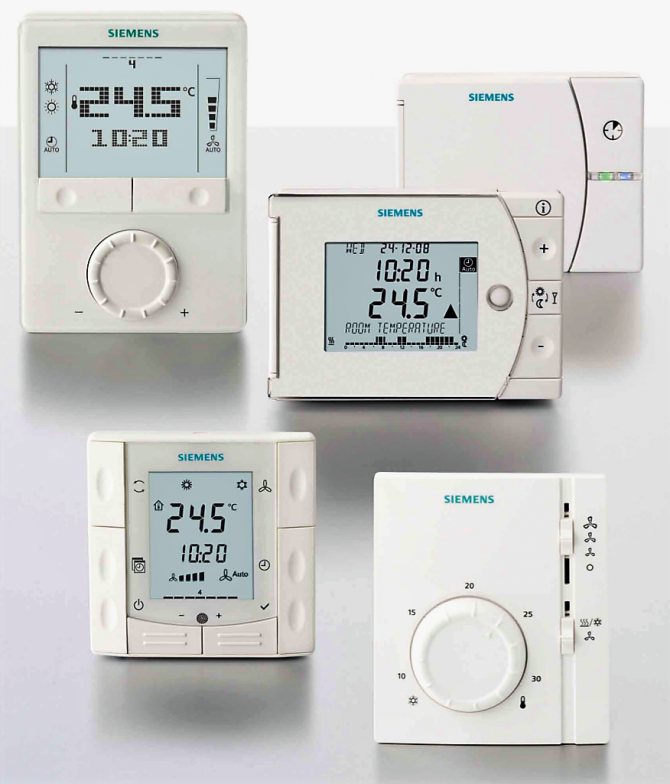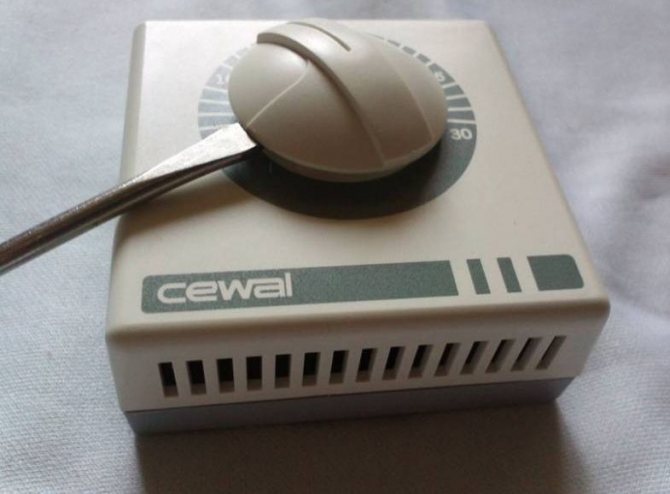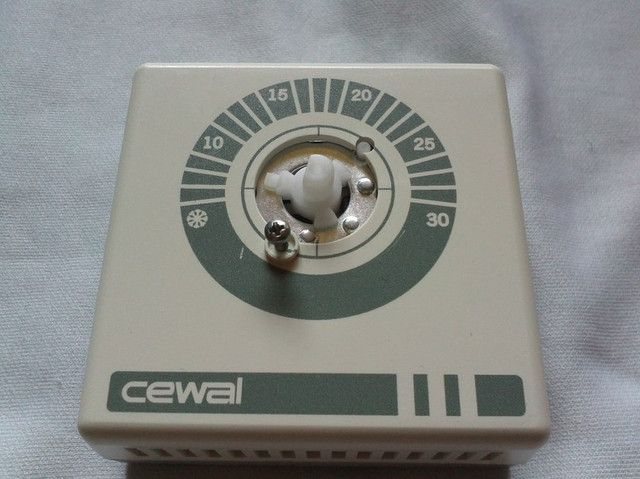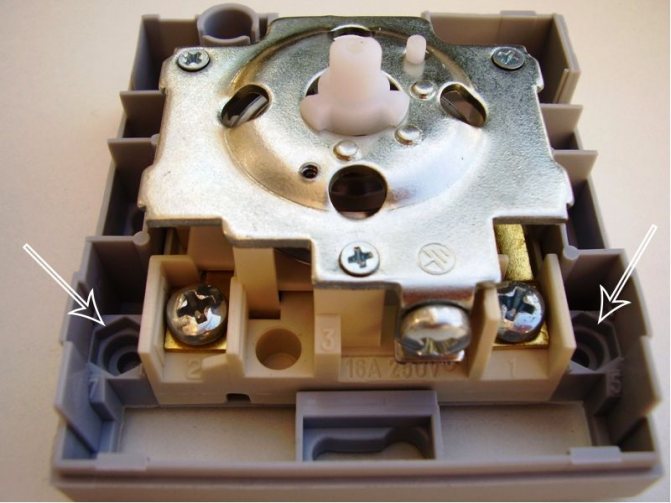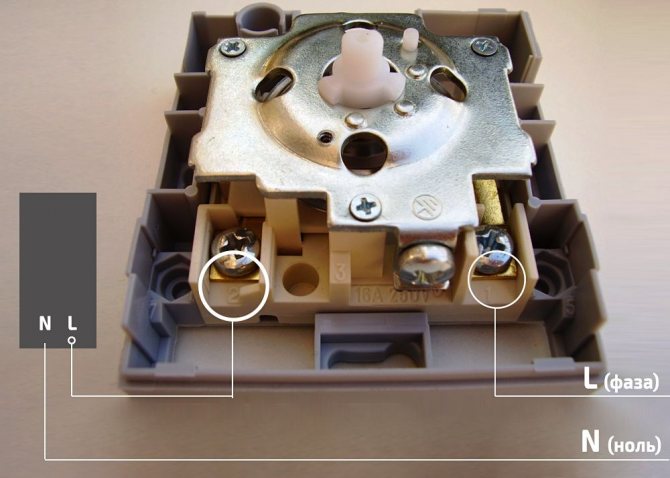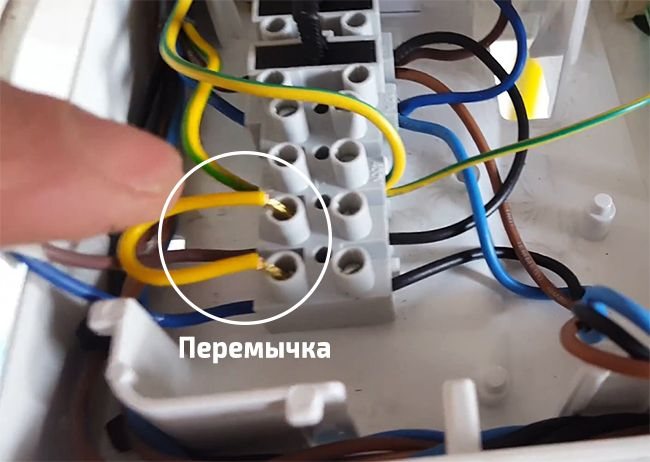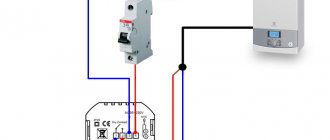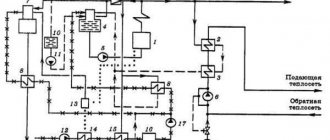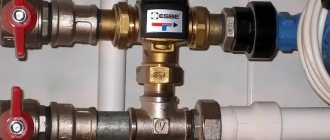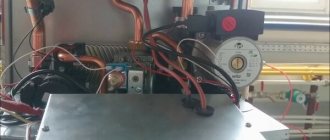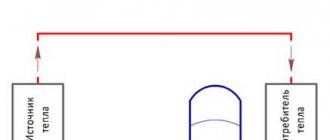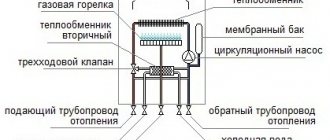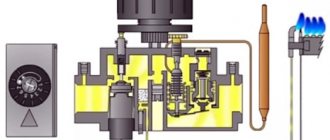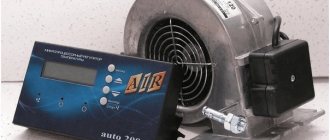In order to achieve a comfortable temperature in the house, we manually control the operation of the gas boiler. This regulation is very relative, since we set the heating medium temperature on the boiler. As soon as the weather conditions change in one direction or another, as the temperature in the rooms decreases or rises, it is necessary to regulate the heating of the coolant on the boiler again. This applies to all gas water heating installations, even expensive ones with a high level of automation. You can get rid of the daily running around in the boiler room if you install a remote thermostat for a gas boiler. Some manufacturers of boiler equipment supply it with their products as an option.
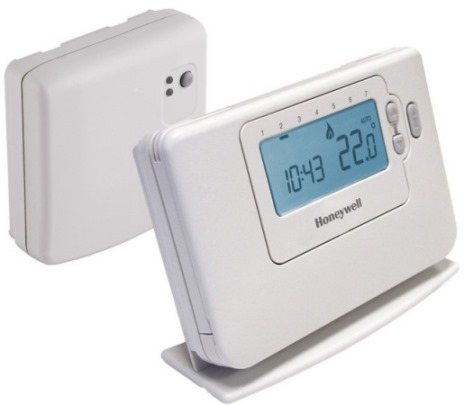
What are thermostats for an electric boiler
What are they for and how they are used
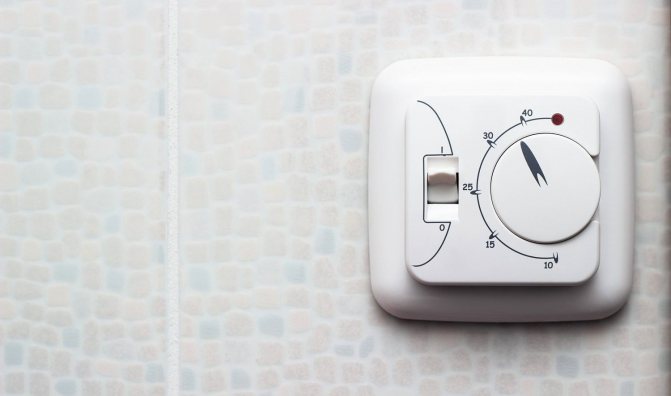

Simple mechanical thermostat.
The temperature controller is a wired or wireless control panel that is mounted on the wall in any convenient place.
There are both simple mechanical models, the functionality of which is smooth temperature control by degrees (especially important for electric boilers with mediocre 3 or 6-step power control), and automatic programmable models with an information display, which allow you to set more than 50 parameters of the boiler operation, program them change for the next day and even a week.
Automatic thermostats allow you to adjust the boiler operation once and up to a whole or even several heating seasons.
In general, room thermostats for electric boilers perform functions such as:
- measurement, control and maintenance of a certain comfortable temperature of the working environment;
- transmission of signals to the electric boiler from any place convenient for the owner in the house;
- protection against overheating or freezing of the heating system;
- programming the operating mode for the next day or week;
- remote control from the phone if there is a Wi-Fi or GSM module in the thermostat;
- remote notification (including via a smartphone) about malfunctions and emergencies in the operation of the heating system.
Existing types
The settings made on the thermostat have priority over the settings of the electric boiler itself. The principle of operation of the device depends on the type of temperature sensor used in it:
1. Mechanical thermostats
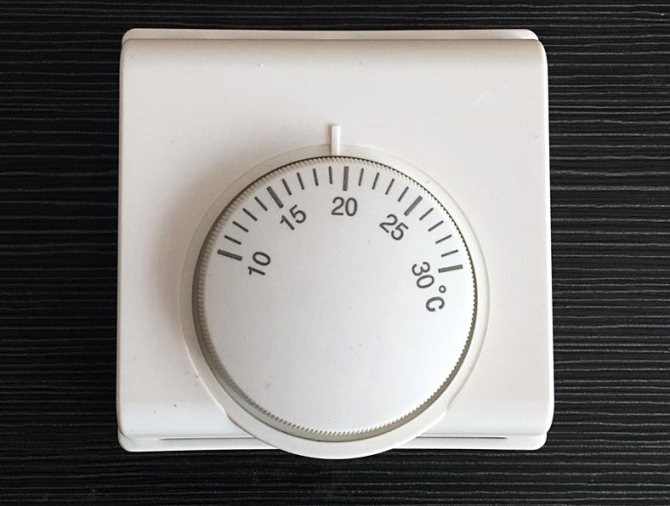

The simplest models, the principle of which is based on the operation of membrane and capillary temperature sensors. They use substances that significantly expand at the slightest increase in temperature, placed in a capsule. The expanding substance, upon reaching the maximum temperature threshold, exerts pressure on the relay membrane, as a result of which the contacts open, the thermostat signals a partial or complete decrease in the power of the electric boiler.
The main disadvantages of such thermostats are simple functionality, limited by turning a round rotary knob to set the desired temperature, and a high error - up to 3-4 ° C.
2. Electromechanical
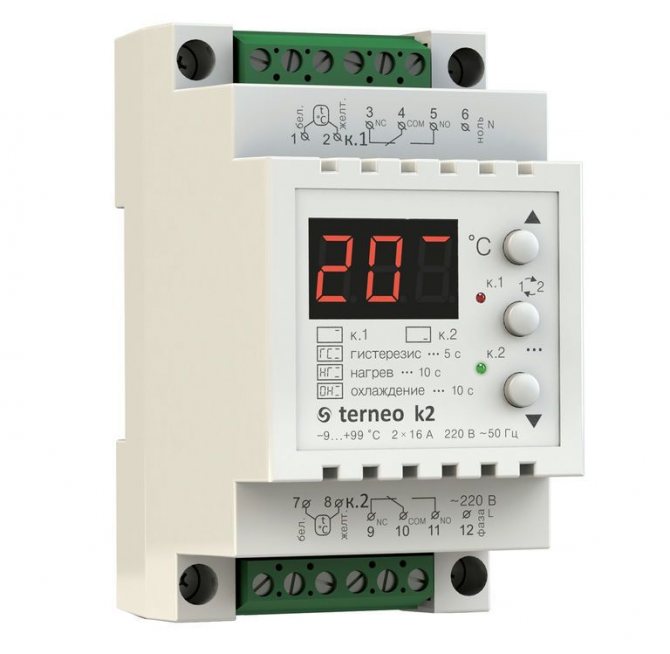

They have a more complex design, based on which special metal plates are used as a temperature-sensitive element, producing a micro-discharge when heated to a certain temperature. The micro-discharge activates an electromagnetic relay that controls the mechanical valve. In general, electromechanical thermostats have + - the same functionality, but a much smaller error, their cost is 20-40% higher.
3. Electronic
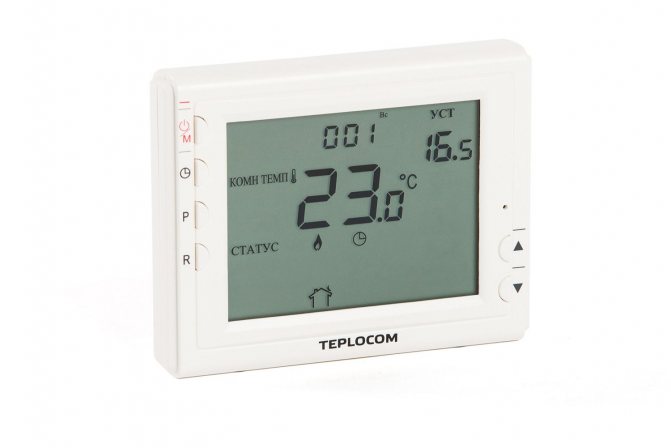

The most modern and multifunctional devices equipped with electrical boards (automation), often with external sensors: both internal and external (outdoor). They are able to maintain or change the operating mode of the electric boiler without human intervention. Allow a minimum error of up to 0.5-0.7 degrees. We recommend paying attention to electronic thermostats in view of their functionality and economy.
Automation of modern models is able to maintain the most economical mode of operation of the electric boiler, constantly adjusting its operation in accordance with the temperature in the working room, which completely prevents unnecessary consumption of electricity. After all, reducing the temperature by 1 ° C is up to 5% savings.
How to choose an external temperature sensor and organize weather-dependent boiler control
Operating tips
The first and, probably, most important advice - before connecting the wired thermostat, you must not start repair work in the room, otherwise, the interior decoration may be hopelessly damaged. The fact is that most often the laying of wires is carried out in the thickness of the walls, for which special grooves are created in them - grooves, and with already completed repairs, strobing can turn out to be a rather serious and unpleasant problem.
The installation of the thermostat must be carried out taking into account the fact that for the correct operation of the device, there must be free space around it. Before connecting the room thermostat, make sure that there are no obstacles or obstacles nearby that impede free access to it.
... Placement of the device is recommended in places where there is no furniture or other bulky interior items, as well as various decorations - carpets, furniture, decorative household items.
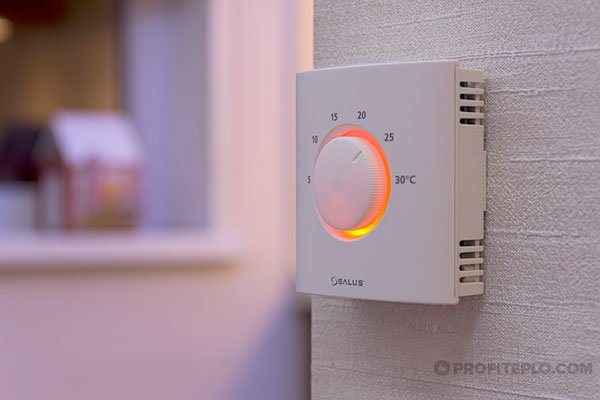

Mechanical thermostat fixed to the wall
Connecting a room thermostat to a wired-type gas boiler and installing it in a room is not at all difficult. The most important thing is to strictly follow the manufacturer's recommendations and not deviate from the instructions and diagrams attached to the device. The way of connecting the cable depends on the brand and type of thermostat.
The coldest living space in the house or the room in which households often gather is best suited for installing the appliance. Do not install the thermostat near household appliances and heating devices, as well as in places where there is a high probability of exposure to direct sunlight.
Installation of the device in rooms where heating radiators with thermal heads are installed is not recommended. It is better to replace such valves with ordinary ones with manual adjustment.
When operating the thermostat, you should adhere to a few simple rules to reduce heating costs:
- when leaving the room for a long time, reduce the temperature of the thermostat to a minimum;
- at night, set the temperature 3-4 degrees lower than during the day, and when waking up, raise the temperature and warm up the premises. It is much easier to regulate the room temperature if you buy a programmable thermostat;
- the device must be constantly maintained in working order, without waiting for shutdown, the batteries must be changed in advance.
How to choose a room thermostat for an electric boiler
Mounting and connection method
According to the technique of fastening and connecting to the electric boiler, wired and wireless devices are distinguished.
Wired thermostats can still be installed in any room, they can have any functionality, but they require a wired connection directly to the electric boiler. Their cost is lower, and in most cases the wire for connection is included in the kit.
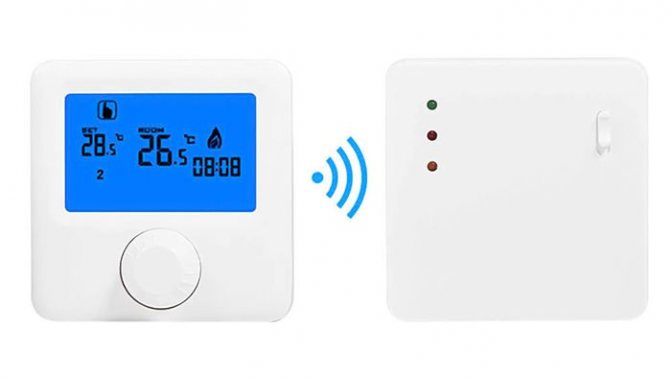

Wireless temperature controllers consist of a control panel and a radio signal receiver connected to the electric boiler by a wired method. The advantages are obvious: when the thermostat is located in a room remote from the electric boiler installation site, there is no need to lay an additional electric wire through the whole house.
According to practice, a 433 or 868 MHz radio signal intended for household appliances does not affect other electronics in the house, it is transmitted without problems through any walls at a distance of 20 or even 30 meters. The disadvantage is the need for additional power supply to the control panel, usually 2 standard AA batteries.
Functionality
Standard simple models have only an on / off switch and a rotary knob (or buttons "+" "-") to set the temperature.
For substantial savings, it is best to opt for a more expensive programmable thermostat that will pay off in the first few months of use. It can be used to lower the room temperature to 15-16 ° C when everyone has gone to work, or 18-19 ° C at night. It is enough to configure several patterns of the electric boiler operation once, the duration of which can be in the range from 8 hours to 7 days.
In addition, programmable models, in addition to the built-in temperature sensor, are often equipped with additional remote ones, including those for heated floors.
Availability of Wi-Fi or GSM-module
The built-in GSM module allows you to receive SMS messages about the operation of the heating system or about an emergency situation that you can immediately resolve. Thus, the coolant will not freeze during a long absence of the owners.
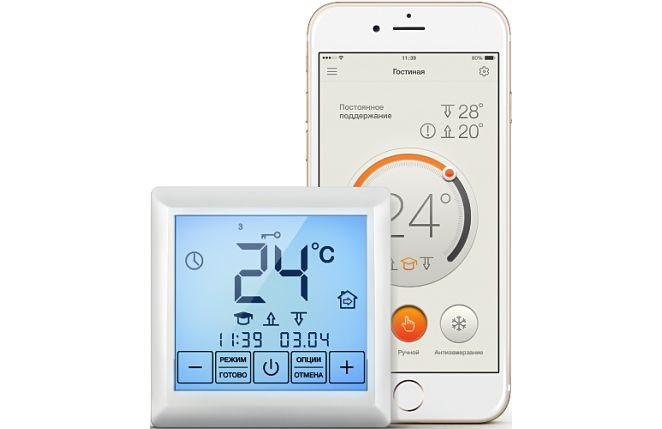

The presence of Wi-Fi allows you to control the operation of the electric boiler through an application on a smartphone. Also, via a Wi-Fi network, you can connect the thermostat to the smart home system or link several additional temperature sensors (including underfloor heating). The presence of Wi-Fi and GSM does not affect the efficiency and economy of the heating system, but increases the comfort of its use.
Protection and safety
In budgetary and even in some models of electric boilers in the middle price segment, basic safety elements such as overheating protection, frost prevention mode or protection against stopping the circulation pump may be missing. Nevertheless, all these elements are present even in many simple models of thermostats in the price range of 1,000-1,500 rubles.
Such security systems should not be neglected especially when temporarily living in a house, when the owners are absent for days or weeks, but the heating system maintains a positive temperature.
Device selection
The thermostat is not the most expensive thing, but not the cheapest one either. A large number of brands of these devices from various manufacturers are presented on the modern market, so you can choose the required device, both in terms of characteristics and functionality, and in terms of cost.
If the main criterion for you is cost, then it is better to opt for a wired electronic version. Such devices are technologically advanced, have a good response, and their reliability does not depend on oxidizing terminals, which is often the case with a mechanical room thermostat.
If, when choosing for you, energy savings are of decisive importance, and with them in the near future and your own funds, then you should purchase a programmable device
... Such a thermostat, which turns on and off strictly at the hours set by the owner, reduces the temperature in rooms when no one is at home, and can significantly reduce heating costs. Programmable devices, as a rule, have several weekly and daily modes.
Programmers make it possible to simplify and optimize the operation of the heating system as much as possible, therefore it is necessary to take a close look not only at them, but also at boilers for non-volatile heat supply.
If the house has already been renovated, and there is no desire to chisel the walls under the channels for wires, the choice in favor of a wireless thermostat with an air temperature sensor is obvious.
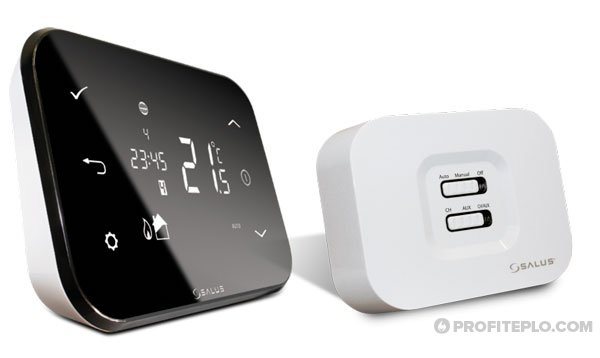

Wireless programmer with air temperature sensor
When buying, you must definitely consult a specialist and independently read the reviews for certain device models.
Many boiler manufacturers also recommend buying a thermostat of their own brand, explaining that the installation and installation of the device in this case will be much faster and easier, and control over heating equipment will be more reliable.
... For example, for a Baxi gas boiler, you need to purchase a thermostat of the same brand. In practice, various devices do not conflict with each other in any way and there are no problems with their interconnection and subsequent operation.
When choosing a thermostat, it is necessary to take into account the area of the room in which it will be installed, and the range of desired temperatures is no less important.
Related article: Hot water heating systems: classification of types
The simplest devices cost about $ 40. Despite the fact that the cost of the devices is quite high, one should not forget about the savings in connection with the decrease in gas consumption - the thermostat will pay for itself soon.
The best known manufacturers and models: characteristics and prices
Cewal RQ-10
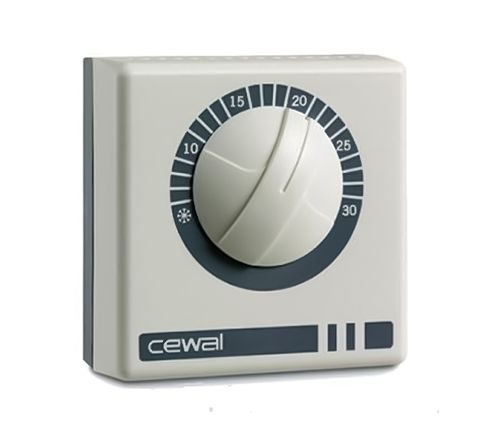

One of the simplest and most affordable mechanical thermostats from an Italian manufacturer. Despite the low cost, it is known for its build quality and reliability. The instructions for the device schematically and in detail indicate the installation and connection algorithm. The only drawback is the large hysteresis - up to 1.5-2.5 degrees, which is typical for all mechanical thermostats.
Cost: 800-1 150 rubles.
SKAT Teplocom TS-2AA / 8A
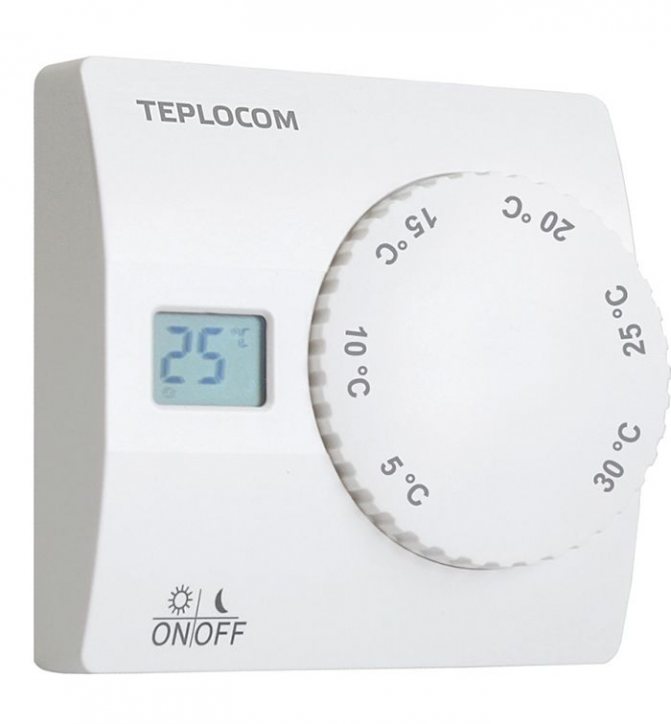

More advanced thermostat with an accuracy of up to 1 ° C. It has a micro-display for temperature indication, it is powered by 2 AA batteries (enough for 10-15 months). Differs in the presence of an economical night mode with automatic temperature decrease by 4 ° C and the presence of frost protection.
Cost: RUB 1,450-1,600
Danfoss ECtemp Next Plus
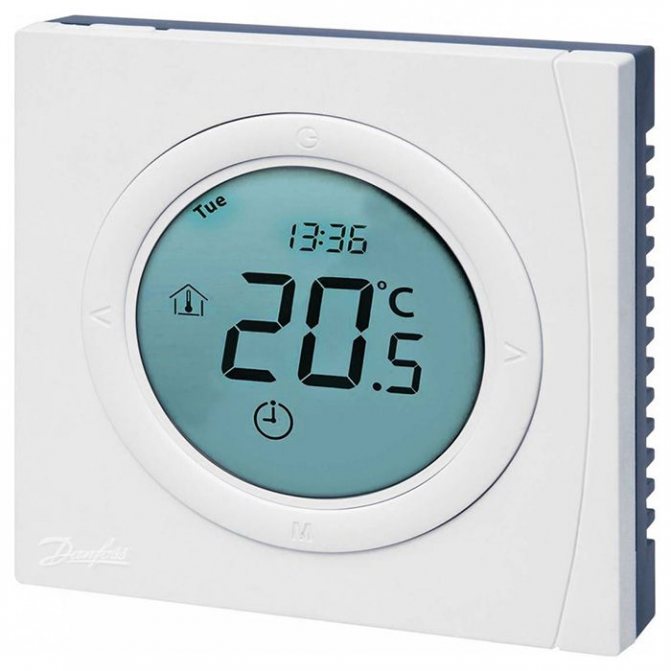

One of the best thermostats for an electric heating boiler in a price-quality-functional ratio. It is a modern electronic programmable thermostat with a stylish design and wide functionality. In addition to the built-in one, it has a remote wired temperature sensor for underfloor heating, which allows control separately from the air temperature in the room. Wide functionality, programming and availability of ready-made modes ("night", "away", etc.) allow you to ensure maximum energy savings.
It is also distinguished by safety: the presence of protection against overheating and freezing, child blocking, monitoring the health of temperature sensors. According to the practice of installation and feedback from the owners, there were no cases of malfunction. In order to avoid malfunctioning, the assembly must fit exactly into the grooves of the plug connector.
Cost: 3 420- 3 900 rubles.
TEPLOLUX MCS-350
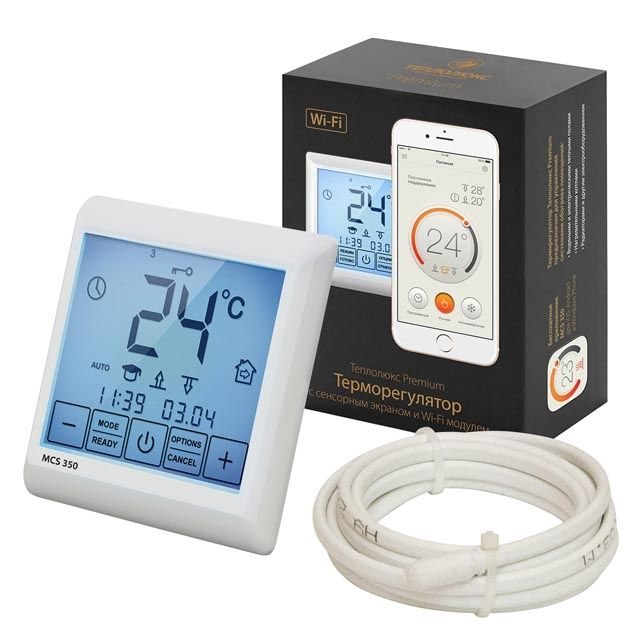

A modern multifunctional premium thermostat with a built-in Wi-Fi module and the ability to control using a special application for a smartphone. It features one of the broadest functionalities, an informative touch screen (with automatic locking) and a stylish design. The set includes both built-in and remote temperature sensors for simultaneous or separate control. Additionally, you can connect up to 32 temperature sensors.
There are template energy-saving operating modes and weekly programming, energy consumption statistics. The connection must be made via a modular contactor.
Cost: 5,900-6,200 rubles.
The principle of operation of the thermostat
The simplest room thermostat is an electromechanical device, the "heart" of which is a thermosensitive element filled with a gas that expands when the air temperature rises. When the user-defined air temperature in the room where the device is installed, the thermosensitive element opens the contacts that connect the device with the heating boiler. This action is a signal for the boiler automation or for the gas valve, which turn off the burner or put it in maintenance mode. It all depends on the model and configuration of the heating equipment.
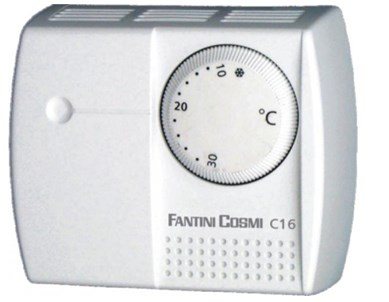

When the boiler stops, the coolant in the circuit cools down. Naturally, this leads to a decrease in the room temperature, while the thermocouple closes the contacts, and the heating system controller starts the burner again.
The advantages of using a room thermostat are as follows: comfort in a heated room depends on the temperature and humidity characteristics of the air, and not the temperature of the coolant in the batteries. Air cools down much more slowly than water. That is why, when using a room thermostat, the most comfortable room temperature for the inhabitants is maintained with a significant decrease in the number of starting the heating boiler.
In other words: using an air thermostat, you increase the service life of the equipment and get a comfortable microclimate in the home, getting rid of frequent adjustments to the operating parameters of the boiler unit, saving money on repayment of the used fuel. Numerous observations show that when using a room temperature sensor, savings on the maintenance of an autonomous heating system are up to 35% per year.
Correct connection of the thermostat to the electric boiler
When choosing an installation site, it must be borne in mind that:
- installation near windows, ventilation or entrance doors is not recommended due to constant temperature changes;
- heated air masses are concentrated near the ceiling, closer to the floor the temperature is lower, therefore it is recommended to install the thermostat at a height of 1-1.5 m;
- Household appliances in the kitchen can generate heat, which affects the accuracy of measuring the overall climate in the workroom.
- it is not recommended to install too close to a frequently closed door;
- direct connection is not recommended if the load exceeds 10 A (connection is made via a modular contactor).
Connection instructions using the example of a mechanical Cewal RQ-10:
| Photo | Process description |
| Remove the rotator |
| Unscrew the screws by removing the front cover of the thermostat |
| Attach the device to the wall using the appropriate holes |
| Connect the ground. According to the diagram in the photo (click to enlarge), it is necessary to connect the thermostat contacts to the electric boiler board. |
| Individually... There can be a jumper between the "TA" contacts of the boiler board; it must be replaced with a two-core insulated cable with a conductor cross-section of 0.5-0.75 mm2. |
Modern thermostats are powered by AA batteries, but connection to the mains may also be required according to the diagram below:
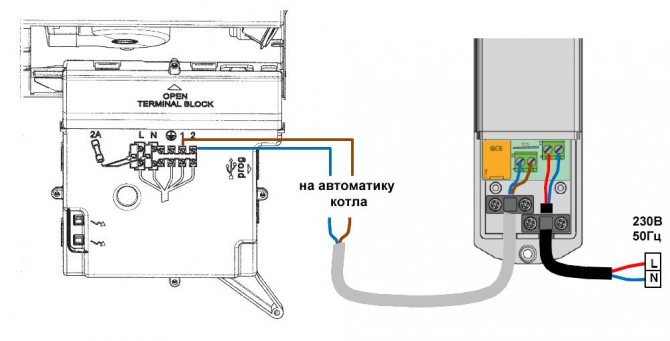

Connection diagrams and a detailed algorithm are described in the instructions for each of the thermostats. However, each case is different and requires certain basic knowledge and skills. Therefore, the traditional advice - in case of difficulties and difficulties, contact the specialists.
Why does a heating boiler need an air thermostat?
All happy owners of autonomous heating know that a boiler is a device that, by burning fuel, heats the water circulating in the heating system.The heating boiler does not work constantly, but cyclically: he heated the coolant to a certain temperature - it turned off. The coolant has cooled down by a few degrees - the boiler has turned on. The heating agent temperature is set manually by the owner, a thermostat, which is an integral part of any modern heating boiler, regardless of its manufacturer and equipment functionality.
This thermoregulation system has several rather serious disadvantages:
- The first inconvenience is that when the weather changes, the owner of the autonomous heating system is forced to visit the combustion room every time and set new temperature values on the boiler. This is not always convenient, especially if the boiler is installed in a separate combustion room.
- In order to maintain the temperature set by the user, the boiler turns on and off the burner quite often. This leads to an increase in fuel consumption and equipment life.
To solve these problems, most manufacturers of climatic technology recommend using room thermostats for a gas boiler. Sometimes on the network you can find the names of this device as: air thermostat, programmer or room temperature sensors.
Advantages of automatic devices for gas boilers
Of course, the main advantage of automation for gas boilers is energy efficiency. Even the simplest programmers can save up to 15% on heating costs - and more expensive and efficient devices will increase this figure by an order of magnitude.
In addition to improving efficiency, automation has the following advantages:
- The operation of heating equipment becomes more stable as the number of on-off cycles decreases.
- It becomes possible to fine-tune the temperature regime, taking into account individual wishes and capabilities.
- The thermostat is easy to install, easy to set up and connect to a gas boiler without any problems. Before connecting the thermostat to a gas boiler, you just need to carefully read the instructions and check with them during operation.
- The operation of the heating system in general and the boiler in particular is greatly simplified.
- The heating system becomes much more reliable and durable.
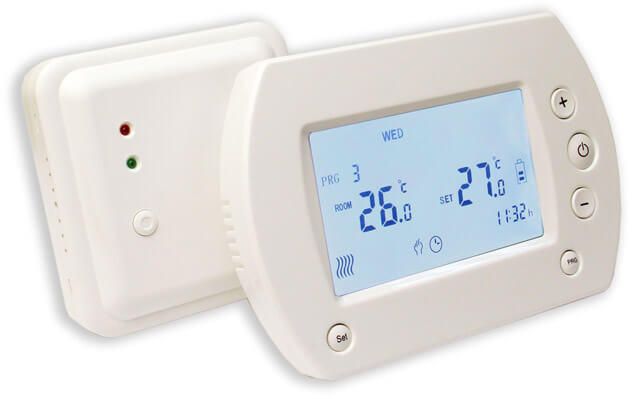

All these advantages are obvious even on a superficial examination, but in practice they turn out to be even more noticeable. When the slightest opportunity arises, you need to connect the room thermostat to the Proterm gas boiler so that its positive qualities can be fully manifested.
Setting procedure
To set up the system and select a comfortable temperature, follow these steps:
- Set the maximum temperature with the remote control.
- Start the boiler and bring it to the optimal operating mode, in which the unit reaches the highest efficiency.
- When the air in all rooms is comfortable warm, take an electronic thermometer and measure the temperature near your regulator.
- Select the measured value on the thermostat as the heater shutdown threshold. Put the required settings in the programmer.
An important clarification. The gas boiler operates with maximum efficiency at a temperature of 80/60 ° C (supply / return).
Let's explain the purpose of the listed manipulations. Due to different areas and heat losses, the temperature in the rooms can differ by 1-3 degrees, so it is better to orient yourself by the degree of heating of the air near the sensor itself.
If the temperature at the point of installation of the regulator is very different from the rest of the rooms, when adjusting, you need to make an allowance for the value of this difference. Some models, for example, Baxi Magic Plus, provide a function for such a correction (called temperature shift).Then it remains only to enter the required value into the device's memory, ranging from 1 to 5 degrees.
General principles of connecting the thermostat
The method and diagrams of connecting the thermostat to the heating equipment itself can be found in the technical passport of the gas boiler. Modern equipment, regardless of the manufacturer, requires connection points for the thermostat. The connection is made using the terminals on the boiler or the thermostat cable included in the delivery.
When using a wireless thermostat, place the measuring unit only in a residential area. This can be the coldest room or the room where the largest number of people gather most often, the nursery.
It is impractical to install a thermostat unit in a kitchen, hall or in a boiler room, where the temperature regime is unstable.
Connection of various types and models of thermostats may have their own characteristics, installation is carried out in accordance with the manufacturer's instructions, which is attached to the device.
Recommendations include a comprehensive description of the regulator operation, connection method and diagrams. Next, we will tell you how to correctly connect the thermostat to a gas boiler and about the installation features of the most typical regulator models.
Mechanical thermostat connection
The mechanical-type thermostat is distinguished by its reliability and simplicity of design, low cost, and long-term operation.
At the same time, it supports only one temperature regime, which is set by changing the position of the knob at the temperature scale mark. Most thermostats operate in a temperature range of 10 to 30 ° C.
The mechanical thermostat has the simplest principle of operation and is triggered by opening and opening the circuit, which occurs using a bimetallic plate. The thermostat is connected to the boiler through the terminal box on the boiler control board.
Installation of an electronic thermostat
The design of the electronic thermostat assumes the presence of an electronic board that is responsible for controlling the device.
The potential serves as a control signal - a voltage is transmitted to the boiler input, which leads to the closing or opening of the contact. The thermostat must be supplied with a voltage of 220 or 24 volts.
An electronically controlled thermostat is used to organize the operation of complex climate systems. It will help in controlling not only an atmospheric or turbine gas boiler, but also a pump, air conditioner, servo drive in the heating system.
How to connect a wireless thermostat?
The wireless thermostat consists of two units, one of which is installed in the living area and acts as a transmitter. The second block is mounted near the heating boiler and connected to its valve or controller.
Data transmission from one block to another is carried out over a radio channel. To operate the device, the control unit is equipped with an LCD display and a small keyboard. To connect the thermostat, set the address of the sensor and install the unit at a point with a stable signal.
The main disadvantage of the wireless thermostat is the power supply of the external unit from the batteries, which have a limited resource and therefore require frequent replacement. To ensure trouble-free operation, the device is equipped with an alarm function that warns of the need to replace the battery.

